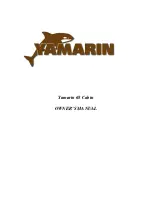
Section 4
4-8
350 Express Series
SELECTING A PROPELLER - INBOARDS, V-DRIVES
1. Ensure that the diameter and pitch provide the desired
performance. The engine RPM at full throttle should be in the
upper half of the recommended full-throttle operating range. If
RPMs are low, a propeller with a smaller pitch will increase RPMs.
If RPMs are high, a propeller with an increased pitch will lower
RPMs.
2. Ensure that the propeller rotation is consistent with engine and
gear box rotation. Your yacht is designed with counterrotating
inboards for minimum torque effects.
3. Ensure that the installation provides adequate safety features
such as a straight key, a propeller nut, a jam nut and a cotter pin.
FUEL SYSTEM (CROSSOVER VALVE)
Your yacht is equipped with an internal fuel system meeting current
federal requirements. The best materials and components available
are used to assemble the fuel system.
The fuel tank outlets to the engines have a manual valve for fuel
shutoff in the event of a line break. To access the manual valves or
tank fittings, open the engine hatch. The valves are on the top of the
fuel tank. These valves are attached to the fuel tank outlet and return
lines. The valves are closed when the handle is perpendicular to the
fuel line, and open when the handle is in-line with the fuel line.
There are also crossover valves between the tanks located inside the
middle section of the cockpit seat base. Lift the cushions up to access
the crossover.
Fuel fill caps are located on the port and starboard aft corners of the
yacht. Near the fill cap is a vent that allows air to move in and out of
the tank as the fuel level changes.
The manual fuel tank valves can control the fuel supply to the
engines in five ways:
1. When both handles point aft, the flow of fuel is shut off.
2. When both handles point forward each engine can receive fuel
from its respective tank; the port engine receives fuel from the port
fuel tank and the starboard engine receives fuel from the
starboard fuel tank.
3. When both handles point outboard, both engines receive fuel from
both tanks.
4. With the port handle pointing aft and the starboard handle pointing
outboard, both engines receive fuel from the starboard tank.
5. With the port handle pointing outboard and the starboard handle
pointing aft, both engines receive fuel from the port tank.
CAUTION
Improper propeller selection and installation could
result in loss of the propeller, and/or excessive
stresses on the drive system leading to drive system
and engine failure. Cruisers Yachts recommends that
you consult with, and employ the skills of, your
Cruisers Yachts Dealer when contemplating a
propeller change.
WARNING
Dual-engine installations normally include a standard
rotation engine and a counterrotation engine. If you
remove the propellers, make sure the propeller is
correct for the rotation of the engine before operating
the yacht. Always follow the instructions in the stern
drive owner’s manual in the Skipper’s Kit when
removing, replacing and selecting a propeller.
Downloaded
from
CruisersOwnersForum
http://www.CruisersOwnersForum.com
















































